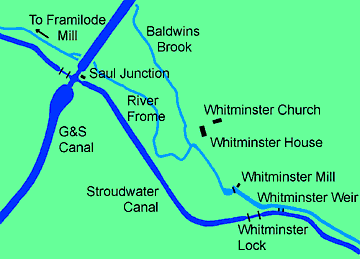Progress of the Conflict
Wednesday 24th April - Soon after Cambridge's blacksmith opened
the sluices, Purnell's men shut them down again.
Thursday 25th April - The sluices were opened and shut again
twice during the day.
Friday 26th April - Cambridge had a high fence erected and a
notice board hung up not to trespass, but Purnell's men arrived
by boat and closed the sluices. Further openings and shuttings continued
until:
Saturday 11th May - Cambridge's men removed the stop boards from
the sluices and took them away by cart, but Purnell's men nailed
new boards in place. Cambridge told his carpenter to remove the
boards, but while this was being done, Purnell himself arrived in
an agitated state and knocked the carpenter down with such violence
that his legs were injured. Purnell was so abusive that Cambridge
called his carpenter away and reported what had happened to Capt
Clegram, the Gloucester Company's engineer.
Monday 13th May - Cambridge and Clegram went to the scene only
to find a mob of about 30 people assembled through the directions
of Purnell. After some time, Purnell arrived and was served with
a legal notice for him and his men to avoid trespassing, but he
immediately led his men forward in defiance of the order.
Tuesday 14th May - Cambridge took his carpenter and sawyers to
cut away the stop boards, but they were physically restrained by
Purnell's men, and after one man was cut in the face by an axe,
Cambridge again withdrew.
Conclusion
These repeated confrontations were eventually brought to an end
by Clegram bringing 60 men from Gloucester at five o'clock one morning
to break the sluice structure entirely to pieces and so let river
water rush freely into the canal. This action provided a breathing
space allowing all parties to calm down and move towards a negotiated
settlement. In 1834, the Gloucester Company obtained a new Act authorising
them to purchase both mills and requiring them to alleviate any
silting problems in the Stroudwater Canal which had caused the original
difficulty.
Sources
Glos RO D2115/2; PRO RAIL 829/6. |
